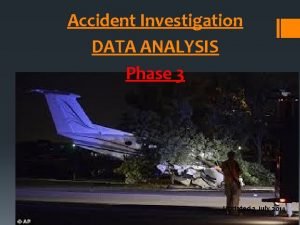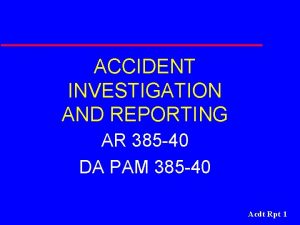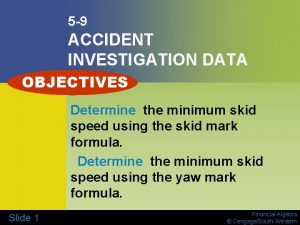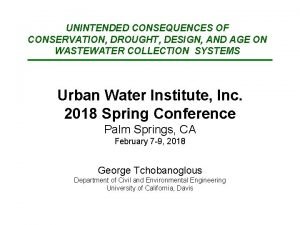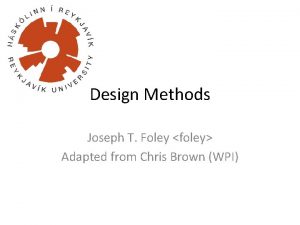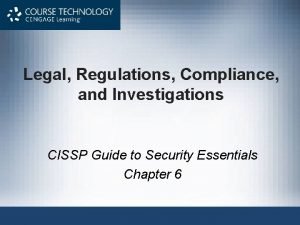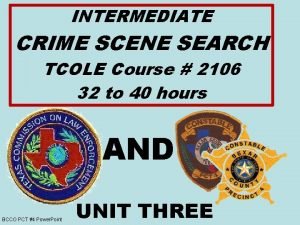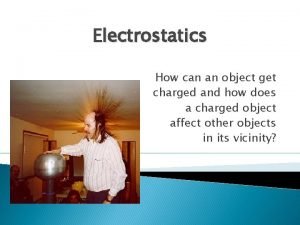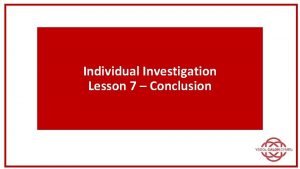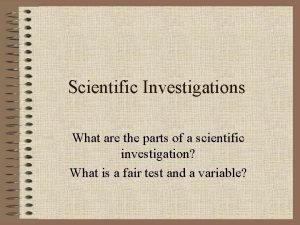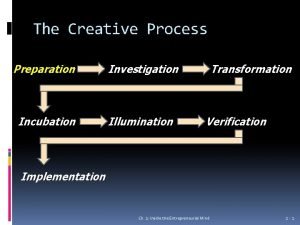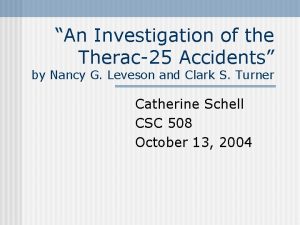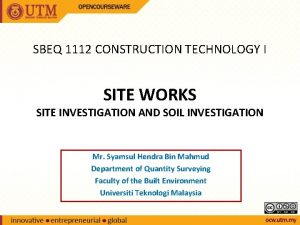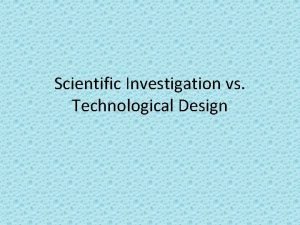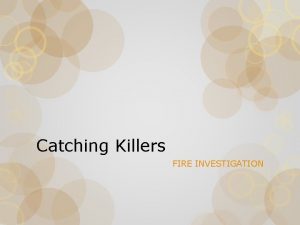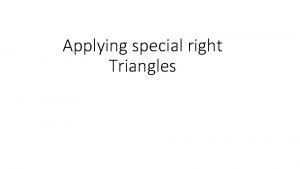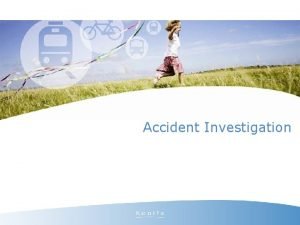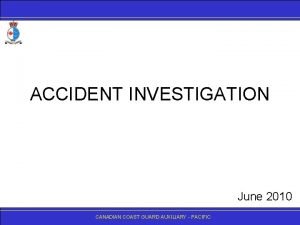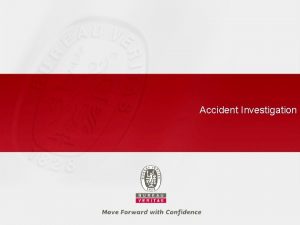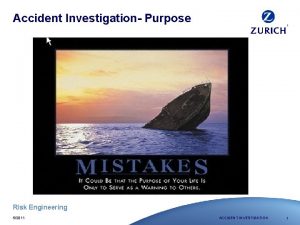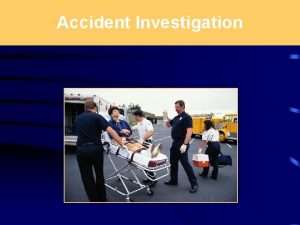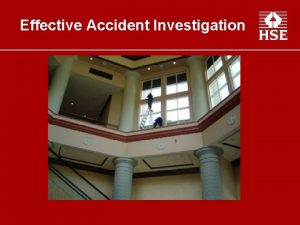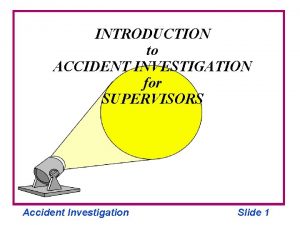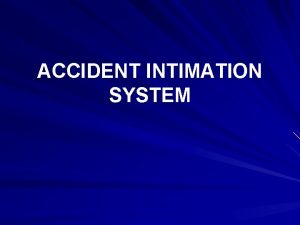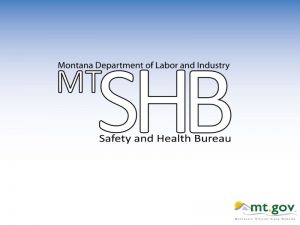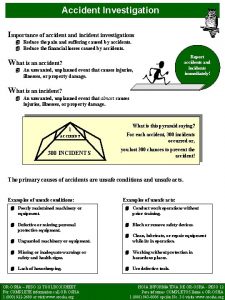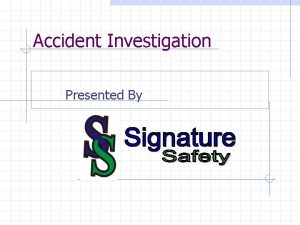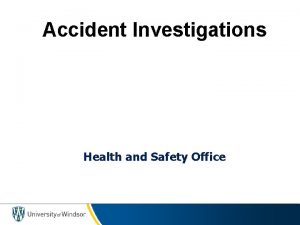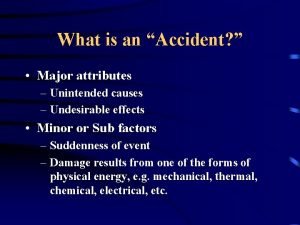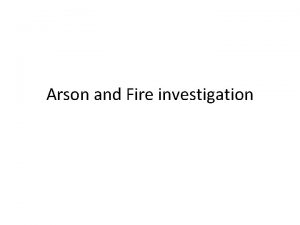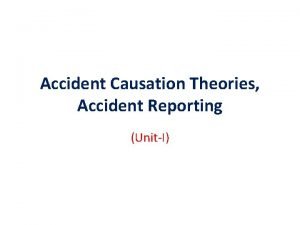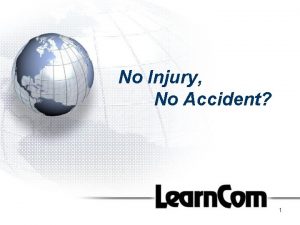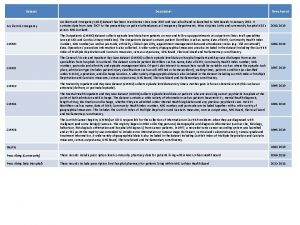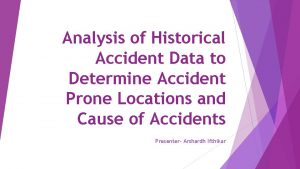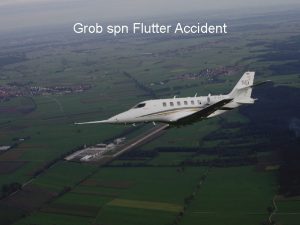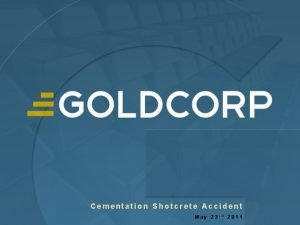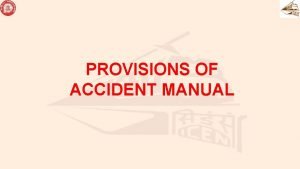Accident Investigation What is an Accident An unintended

























- Slides: 25

Accident Investigation

What is an Accident? An unintended happening, mishap. n Most often an accident is any unplanned event that results in personal injury or in property damage. n The failure of people, equipment, supplies or surroundings to behave or react as expected causes most accidents. n

Accident Investigation Will determine how and why of failures. n Examine possible corrective action. n Aid in the accident prevention and elimination of a clearly identified hazard. n n Most important-Investigation is not intended to place blame.

The Three Basic Causes Poor Management Safety Policy & Decisions Personal Factors Environmental Factors Unsafe Act a es s u D t. C c ire Indirect Causes Unplanned release of energy and/or Hazardous material Basic Causes Unsafe Condition ACCIDENT Personal Injury Property Damage

Be Prepared Develop contingency plans prior to the accident. n Designate an investigator n – This person should only be responsible for investigating. – Should have a good working knowledge of operating procedures. n Be equipped with the right tools to do the job thoroughly.

Record the Facts Interview witnesses as soon as possible. n Document the accident scene before any changes are made. n – Take photos – Draw scaled sketches – Record measurements n Gather support documents such as maintenance records, reports, production schedules or process diagrams.

Record the Facts Keep all notes and remarks in a bound notebook or three ring binder. n Record: n – Pre-accident conditions – Accident sequence – Post-accident conditions n Document victim location, witnesses, machinery, energy sources and other contributing factors.

Record the Facts Even the most insignificant detail may be useful. n Document and then document some more. n The investigator should be concentrating solely on the investigation at hand. n

Interviewing Excellent source of first hand knowledge. n May present pitfalls in the form of: n – Bias – Perspective – Embellishment n It is important to maintain a clear thought process and control of the interview.

Interviewing Get preliminary statements as soon as possible from all witnesses. n Locate the position of each witness on a master chart (including the direction of view) n Explain the purpose of the investigation (accident prevention) and put each witness at ease. n

Interviewing Let each witness speak freely and take notes without distracting the witness (use a tape recorder only with consent of the witness). n Use sketches and diagrams to help the witness. n Emphasize areas of direct observation and label hearsay accordingly. n Record the exact words used by the witness to describe each observation. n

Interviewing Word each question carefully and be sure the witness understands. n Identify the qualifications of each witness (name, address, occupation, years of experience, etc. ). n Supply each witness with a copy of their statements (signed statements are desirable). n

Problem Solving Techniques Change Analysis This technique emphasizes change to correct the problem. n Examination of deviations from the norm are scrutinized. n Consider all problems to result from some unanticipated change. n Analyze the changes to determine its cause. n

Problem Solving Techniques Change Analysis n Use the following steps in this method: – Define the problem (What happened? ). – Establish the norm (What should have happened? ). – Identify, locate, and describe the change (What, where, when, to what extent). – Specify what was and what was not affected. – Identify the distinctive features of the change. – List the possible causes. – Select the most likely causes.

Problem Solving Techniques Job Safety Analysis n n n Job safety analysis (JSA) is part of many existing accident prevention programs. In general, JSA breaks a job into basic steps, and identifies the hazards associated with each step as well as prescribing controls for each hazard. A JSA is a chart listing these steps, hazards, and controls. Review the JSA during the investigation if a JSA has been conducted for the job involved in an accident. Perform a JSA if one is not available to determine the events and conditions that led to the accident.

Problem Solving Techniques Job Safety Analysis

Investigation Report An accident investigation is not complete until a report is prepared and submitted to the proper authorities. n Suggestion of items to include in your report. n

Investigation Report n Background Information – Where and when the accident occurred – Who and what were involved – Operating personnel and other witnesses n Account of the Accident (What happened? ) – Sequence of events – Extent of damage – Accident type – Agency or source (of energy or hazardous material)

Investigation Report n Discussion (Analysis of the Accident - HOW; WHY) – Direct causes (energy sources; hazardous materials) – Indirect causes (unsafe acts and conditions) – Basic causes (management policies; personal or environmental factors)

Investigation Report n Recommendations (to prevent a recurrence) for immediate and long-range action to remedy: – Basic causes – Indirect causes – Direct causes (such as reduced quantities or protective equipment or structures)

Discussion of OSHA Investigated Accidents Utilizing information collected by OSHA investigated accidents and available at the website: http: //www. osha. gov/cgi-bin/inv 1 several accidents will be discussed. n

Accident #1

Accident #2

Accident #3

Any Questions ? ?
 Accident investigation data analysis
Accident investigation data analysis Army accident investigation
Army accident investigation 5-9 accident investigation data answers
5-9 accident investigation data answers Unintended consequences
Unintended consequences Unintended consequences
Unintended consequences Drug diversion investigation checklist
Drug diversion investigation checklist Investigation for thyroid
Investigation for thyroid What makes hard water hard lab investigation 3 answers
What makes hard water hard lab investigation 3 answers Legal regulations compliance and investigation
Legal regulations compliance and investigation Personal investigation a level art
Personal investigation a level art Intermediate crime scene investigation tcole
Intermediate crime scene investigation tcole Phet charges and charged objects investigation
Phet charges and charged objects investigation Vce scientific poster
Vce scientific poster Conclusion of investigation
Conclusion of investigation Parts of an investigation
Parts of an investigation Illumination in entrepreneurship
Illumination in entrepreneurship An investigation of the therac-25 accidents
An investigation of the therac-25 accidents 1 11 121 triangle
1 11 121 triangle Grid linear spiral and quadrant are all
Grid linear spiral and quadrant are all Soil investigation methods
Soil investigation methods Technological design and scientific investigation
Technological design and scientific investigation Catching killers fire investigation
Catching killers fire investigation Multiplication investigation
Multiplication investigation Yale center for clinical investigation
Yale center for clinical investigation How to find value of x in triangle
How to find value of x in triangle Surface area investigation
Surface area investigation
